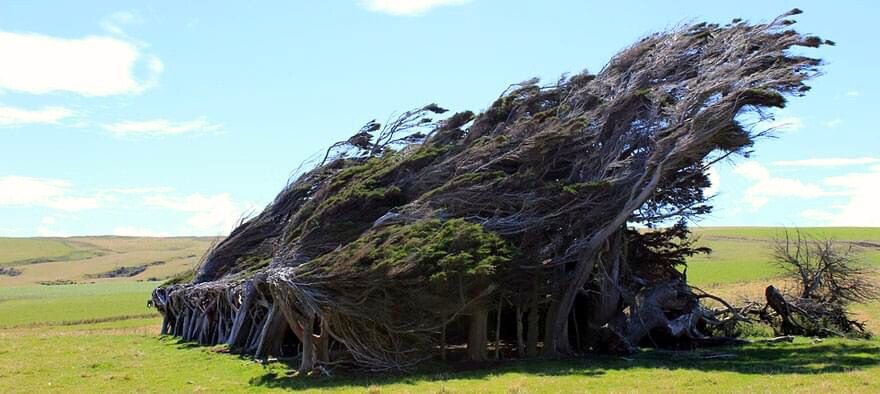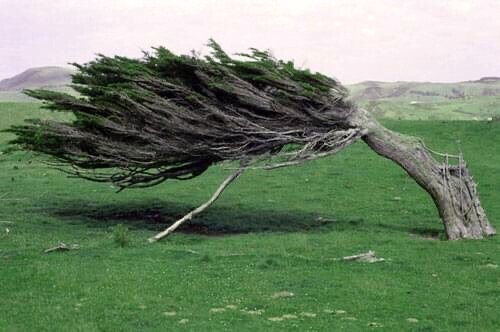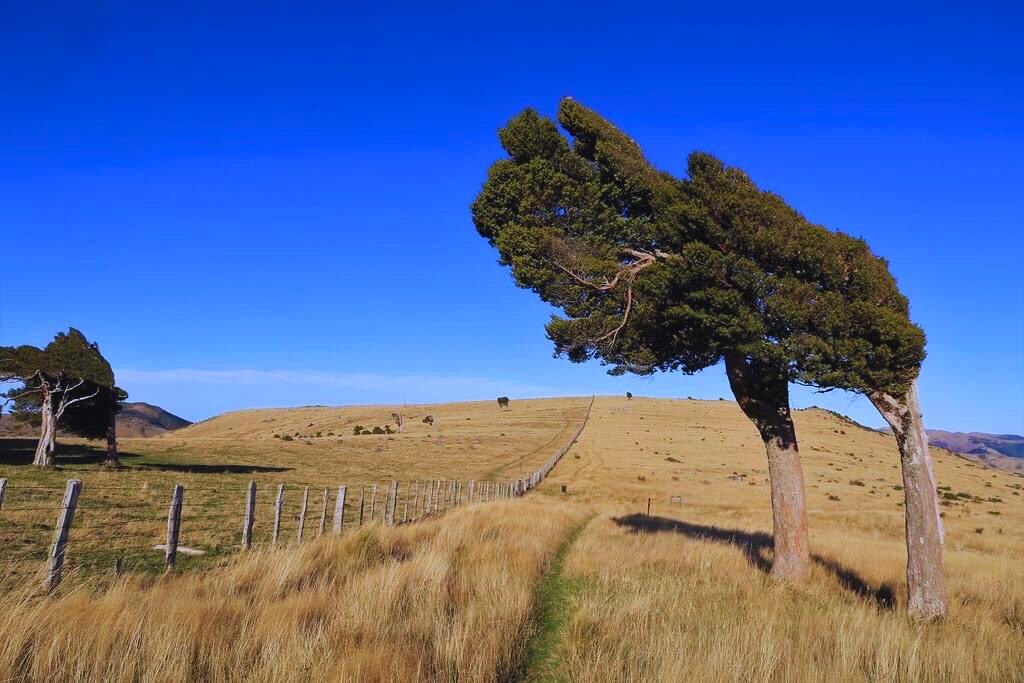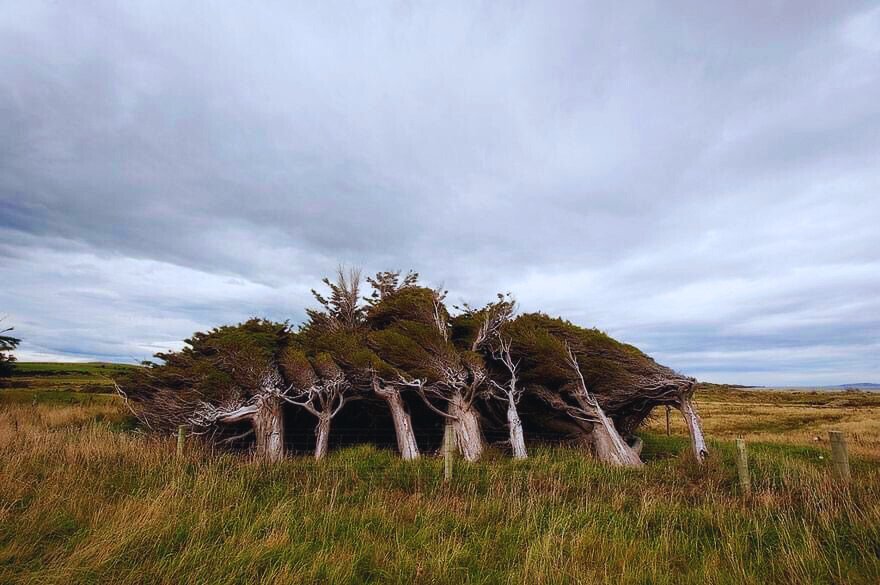Just picture yourself on the bleak moors of Banks Peninsula in New Zealand, the soils and eroding cliffs narrating tales of endurance and evolution. Here trees do not grow up to the heavens but spread out like claws, shaped by the monotonous sea breeze. Although this form of tree growth is beautiful to look at, it is a clear sign of how strong the natural world is. It enlightens the ecological balance and adaptability in extreme conditions, a circumstance that helps plants to survive. This specific adaptation apart from demonstrating the trees’ endurance also enriches the area with enchanting scenery and turns it into the object of research for both environmentalists and tourists.
1. The Geographical Setting of Banks Peninsula
1.1. Overview
Banks Peninsula, on the South Island of New Zealand is a large volcanic bulge extending into the Pacific Ocean. It is characterized by hilly terrains and deep harbors, which were created by volcanic activity that took place more than eight million years ago. The climate in this region is maritime with moderate temperature and moderately high humidity. This environment when complemented with rich volcanic soil conducive to farming hosts a very diverse plant and animal life.

1.2. History
The early formation of Banks Peninsula reflects its volcanic origin. Originally, it was two distinct volcanic islands that through multiple processes such as erosion and sedimentary accumulation became connected, forming the current peninsula-like structure. It has experienced several climatic shifts, from balmy heat to biting frost, which have greatly impacted its evolution and the inhabitants of the flora.
1.3. Importance of Location
The geographical location of Banks Peninsula stands out. Stretching out into the ocean, it is directly exposed to the prevailing easterly winds blowing across the Pacific. These winds are not only powerful, but they are also rather constant and have a significant impact on the formation of the peninsula and its vegetation. The trees are shaped by these persistent winds and thus stand as a living example of the actions of sculpting forces in the natural world, thus making the peninsula a framework of ecological and evolutionary change.
2. Understanding the Wind Patterns
2.1. Types of Winds
Another weather factor that affects the Banks Peninsula is the Antarctic winds, which are also referred to as the Roaring Forties. These are Antarctic-origin winds that move to the north and accelerate as they are concentrated by the geographic constraints of the open ocean. They are characterized by strength that is unrelenting and they are considered dominant especially during the winter.

2.2. Impact of Winds
The effects of these strong winds occurring frequently are evident on the climate and vegetation regime of Banks Peninsula. This is due to the fact that the climate is cooler and the air is moister which impacts the local weather and the precipitation. Vegetation is specially suited to these conditions; the trees and plants are dwarfish and twisted, and defy all rules of tree growing by growing in unnatural directions.
2.3. Comparison
There are similar examples of vegetation formations influenced by the winds in other regions of the globe. For example, the trees found in the Slope Point of southern New Zealand have similar growth patterns due to the force of the wind. Internationally, there are such phenomena as the “drunken forests” in some regions of Alaska, where trees grow tilted due to the uneven freezing and thawing of the ground, although for other reasons. These comparisons show that wind influences ecosystems on a worldwide level, but each place responds differently to the challenges of the environment.
3. Botanical Insights into Tree Growth
3.1. Biology of Trees
Trees produce cells in a layer called the cambium, which is found just beneath the bark of plants. This process can lead to trees to be taller and thicker in the long run. Also, trees undergo change in growth to the change that takes place in its environment; these are light, water, and wind. Etling argues that adaptability could be a strategy for endurance in rigorous conditions such as the aforementioned Banks Peninsula.

3.2. Specific Adaptations
On the Banks Peninsula, trees exhibit remarkable adaptations to withstand the extreme winds. One key adaptation is the flexibility of their trunks, which allows them to bend rather than break under the force of the wind. Another adaptation is the reduced leaf size, which minimizes the surface area exposed to the wind and reduces water loss due to evaporation. These adaptations help the trees to not only survive but thrive in their windy environment.
3.3. Photosynthesis Challenges
Sideways growth, which is typical for trees in Banks Peninsula, presents difficulties to photosynthesis, the process that allows turning sunlight into energy. When trees grow sideways, their leaves may be oriented in such a way that they will have limited access to light to enable photosynthesis. This can affect tree health by decreasing the available energy in a tree for growth and repair services. Nevertheless, these trees manage to defend themselves in yet another way: by properly positioning leaves and their angles to allow them to capture as much sunlight as possible.
4. Ecological Impact and Environmental Significance
4.1. Ecological Roles
Banks Peninsula has specially evolved trees that help regulate the bio-diversity of the region. They also offer shelter and food to different birds, reptiles, insects, and other animals that depend on these trees for survival. The trees’ resistance to powerful winds also assists in combating soil erosion thus creating a stable environment to support other living organisms.

4.2. Conservation Importance
For these reasons, it becomes necessary to employ conservation strategies to safeguard the tree architecture of Banks Peninsula. Measures such as this include protection of areas that these trees grow from human interference and other activities that may cause disruption in the natural environment. Conservation also allows the trees to reproduce naturally which replenishes the genetic pool of these trees. When such trees are protected, an individual is in a position to conserve the species, the general cover and productivity of that particular region.
4.3. Lessons on Resilience
Patterns of growth in the trees at Banks Peninsula are some of the significant evidence of ecological endurance and adaptability. These trees are the examples of how organisms can change their forms and rates of growth depending on the conditions they face. Learned about these adaptations gives an insight into how nature bounces back especially in various areas affected by the effects of climate change. It is for this reason that one must preserve and research other habitats and understand how life on this planet can evolve in order to survive the Earth’s dynamic environment.
5. Human Interaction and Cultural Significance
5.1. Local Culture
Locally, the trees which are blown by the winds on the Banks Peninsula have entwined themselves with the society. Traditionally, these trees have defined the hardness of the land and its people. The local folklore is replete with stories in which trees are depicted as strong and unyielding which may be associated with this characteristic. Furthermore, these trees have not only been used practically, for instance, as directional trees and in traditional arts.

5.2. Tourism
The unique appearance of these trees makes Banks Peninsula a magnet for tourists seeking natural wonders and scenic landscapes. The tourism generated by these attractions supports local businesses and promotes a broader awareness and appreciation of New Zealand’s natural heritage.
5.3. Educational Value
The phenomenon of tree growth under extreme wind conditions serves as a live classroom for both educational and scientific pursuits. It offers a practical demonstration of ecological adaptation and resilience, making it a valuable tool for teaching biological and environmental sciences. Researchers study these trees to gain insights into how different species adapt to environmental stressors, providing valuable data that can help predict how vegetation might respond to changing climates worldwide.
Sum Up
In this journey of discovering the Windswept trees of the Banks Peninsula we have seen how these organisms go through the dynamics of surviving nature at its best. These trees can bend but cannot be broken, an aspect that shows how strong the trees are. Its growth pattern which has been attributed to the powerful Antarctic winds is not only entertaining to watch but also has critical ecological functions in the natural world.
This phenomenon teaches us much about nature’s incredible capacity to adapt and persevere in the face of challenges. It is a vivid reminder of the resilience embedded in the natural world, and how ecosystems can adjust to even the most extreme conditions.
As we reflect on the resilience of these trees, let us also consider our role in preserving such wonders. Could we, as stewards of the Earth, learn from these natural adaptations to better care for our environment? Let this be a call to action for further research and conservation efforts, ensuring that future generations can also learn from and be inspired by the enduring strength of nature.
Also you can read an article about Scaligero Castle: The Enigmatic “Sinking Castle” of Lake Garda and more amazing articles in our website Bamboospanda.








